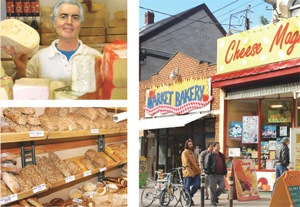
Kensington
By on Aug 29, 2007

Originally part of a 100-acre park lot
granted to Captain John Denison in 1815,
Kensington developed into a middle classAnglo-Saxon neighbourhood with distinctive
British street names like Kensington Avenue,Fitzroy Terrace, Oxford Street, and Wales Avenue.
The neighbourhood began to change in the early
1900s when Jewish immigrants from Eastern
Europe started to settle there. Excluded from theToronto business community, Kensington?s Jewish families opened stalls in front of their houses, and
sold goods to each other. This Jewish market was thestart of an old world marketplace in the heart of the
Kensington neighbourhood.
Today the area represents the true meaning of
the word eclectic, with people from more than 30
cultural backgrounds, including Portuguese, EastIndian, Ethiopian, and Caribbean.
Defined by its popular outdoor market,
Kensington has become a hot spot for tourists and a
popular Toronto shopping destination.
The Kensington Market is the city's only year-round
outdoor market. It is a place of organized
confusion; where merchants sell their goods rightout on the sidewalks and restaurant radios trumpet
the words and music of a far-off land. It is a havenof fresh fruit, vegetables, and dry goods stores. Some
of the best local produce and meat shops are foundon these cramped little streets, and the seafood, dry
goods, and dollar stores on Spadina are just a fewblocks away. Kensington Avenue itself also houses
several cafes and some of the best vintage clothingstores in the city.
The shopping on the periphery of the Kensington
neighbourhood includes Chinatown on SpadinaAvenue, Portugal Village on Dundas Street West,
and the trendy shops and restaurants along QueenStreet West.
The local park and meeting place for Kensington
residents is Bellevue Square, which is locatedright in the centre of the neighbourhood and has a
children?s playground and a wading pool.
Cecil Community Centre at Spadina and
College features a large hall that is used for theatre productions, sports, parties, and weddings.

The Shaw College Public Library serves as a
meeting place and offers reading material in a
number of languages that reflect the culturaldiversity of Kensington residents.

Streetcar service on Bathurst Street connects
passengers to the Bloor-Danforth subway line. TheSpadina, Dundas, and Queen streetcars travel to the
Spadina Station on the Yonge-University-Spadinasubway line. Motorists are already downtown and
are just minutes from the Gardiner Expressway andLake Shore Boulevard.
Many of the area's Victorian row houses, built
between the 1870s and 90s, are small to moderate insize and feature decorative accents. The houses in
the heart of the Kensington Market have marketstalls on their front lawns and many are oriented to
the rear of the property where small lanewaysoffer privacy from the hustle and bustle of the
marketplace.
The Kensington neighbourhood is presently
being revitalized by a handful of new housing
projects. These new developments include Victorianinspired townhomes that are situated on Oxford
Street and the Kensington Market Lofts, a uniquecondominium project situated in three former
George Brown College buildings on Baldwin andNassau Streets.
Community Resources
City of Toronto
Kensington Market
Toronto Public Library
Toronto District
School Boardwww.tdsb.on.ca or 416-397-3000
Toronto Catholic District
School Board
Toronto Transit
Commissionwww.ttc.ca or 416-393-INFO(4636)
Cycling Information
www.toronto.ca/cycling/index.htm
Toronto Police Hotline
416-808-2222


